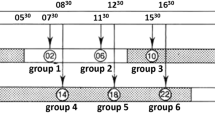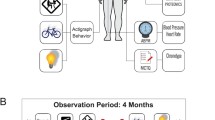Summary
Methods are presented for qualifying clinical reference intervals, for individuals as well as peer groups, according to circadian and other rhythms, using chronobiologically-defined single samples or time series.
Similar content being viewed by others
References
The term is derived from ‘chronos’, time, and ‘desmos’, bond, even if ‘desmos’ is here taken to denote something more like ‘bound’ or ‘band’ than like ‘bond’. Unless a more appropriate and succinct term can be proposed, the word chronodesm may be used with poetic (if not scientific) license. Names may also be appropriate for different kinds of chronodesms. The term ‘monodesm’ may indicate that all data used to derive a chronodesm were obtained at a) a single timepoint or b) during a single timespan shorter than the period of a particular rhythm under consideration. Thus, a monodesm would be a conventional reference interval applicable to a single timepoint or timespan. The term ‘rhythmodesm’ may refer generally to a chronodesm based on any satisfactory mathematical model for a given rhythm, applicable to all stages of the rhythm. If a single cosine curve is an appropriate model, one may use a more specific term: ‘cosinordesm’. If a statistically-significant model with normally-distributed residuals cannot be found, with or without data transformation, one may resort to constructing a ‘merodesm’, in which reference intervals are computed separately at each of several different timepoints or stages of a given rhythm, i.e., as a set of monodesms. The terms may be eventually qualified as to whether it applies to an individual-idiochronodesm — or to a population — panchronodesm. The term may be further qualified as to the model used.
The subscript capital i (I) denotes a time used for prediction, which may or may not coincide with an actual sampling time denoted by a small i (i).
H.W. Lilliefors, J. Am. Stat. Ass. June 1967, p. 399.
W.J. Dixon and F.J. Massey, Introduction to Statistical Analysis, 3rd ed. McGraw Hill, 1969.
Documenta Geigy Scientific Tables, 7th ed. Ed. K. Diem and C. Lentner. J.R. Geigy, 1970.
L. Elveback and W. Taylor, Ann. N. Y. Acad. Sci.161, 538 (1969).
G.J. Hahn, J. Qual. Technol.2 (1970).
F. Halberg, Z. Vitam.-Horm.-u. Fermentforsch.10, 225 (1959).
F. Halberg, A. Rev. Physiol.31, 675 (1969).
F. Halberg, Hosp. Practice12, 139 (1977).
E. Halberg, M. Connolly, F. Halberg, E. Yunis, L. Baily, E. Nelson, F. Carandente, M. Cagnoni, P. Scarpelli, R. Lauro, H. Levine, C. Delea, F.C. Bartter and E. Haus, Chronobiologia3, 72 (1976).
F. Halberg, G. Cornelissen, F. Carandente and G. Katinas, Chronobiologic glossary 1977. Publishing House, II Ponte, Milano, Italy. Chronobiologia4, suppl. 1, 199.
F. Halberg, B.D. Gupta, E. Haus, E. Halberg, A.C. Deka, W. Nelson, R.B. Sothern, G. Cornelissen, L.E. Scheving and E.R. Burns, XIVe Congr. int. Thér., 8–10 September 1977, Montpellier, France, p. 151.
E. Halberg, F. Halberg, E. Haus, G. Cornelissen, L. Wallach, M. Garcia-Sainz, H.W. Simpson, M. Gautherie, A.R. Shons, M. Smolensky and L.E. Scheving, Chronobiologia (in press).
F. Halberg, E.A. Johnson, W. Nelson, W. Runge and R.B. Sothern, Physiol. Teacher1 1 (1972).
J. Halsted, The Laboratory in Clinical Medicine. W.B. Saunders Co., 1976.
E.K. Harris, Clin. Chem.21, 1457 (1975).
E.K. Harris, P. Kanofsky, G. Shakarji and E. Cotlove, Clin. Chem.17, 1022 (1970).
R. Henry, D. Cannon and J. Winkelman, Clinical Chemistry, 2nd ed. Harper and Row 1974.
L.E. Scheving, Endeavor35, 66 (1976).
L.E. Scheving, H. v. Mayersbach and J.E. Pauly, J. Eur. Tox.7 (4), 203 (1974).
H. Simpson, Essays Med. Biochem.2, 115 (1976).
W. Sunderman, Clin. Chem.21, 1873 (1975).
W. Wallis, 2nd Berkeley Symposium on Probability and Statistics. University of California Press, 1950.
On practical grounds, the much more generally applicable tolerance interval is preferred to a prediction interval. However, for unique decisions such as those concerning the surgical removal of an organ (or for some other unique or very rare inference) the prediction interval (estimating the interval in which a very few or only a single future observation might fall) may yield at least theoretically a narrower band8. In such rare cases, a prediction interval may be preferable to a tolerance interval. If, then, a time-qualified prediction interval is given the term predictionchronodesm and the variations of this term described above can be advocated. The term chronodesm, without further qualification, will invariably refer to a time-qualified tolerance (rather than prediction) interval.
Author information
Authors and Affiliations
Additional information
Supported by the Hoechst Italia Foundation, US Environmental Protection Agency (R804512-01-0), US Public Health Service (5-K6-GM-13, 981), National Cancer Institute (1R01-CA-14446-01), Cancer Supplement (CA-14445-01S1), National Institute of Aging (A6-00158) and National Institute of Occupational Safety and Health (OH 00631).
Rights and permissions
About this article
Cite this article
Halberg, F., Lee, J.K. & Nelson, W. Time-qualified reference intervals — chronodesms. Experientia 34, 713–716 (1978). https://doi.org/10.1007/BF01947276
Issue Date:
DOI: https://doi.org/10.1007/BF01947276




